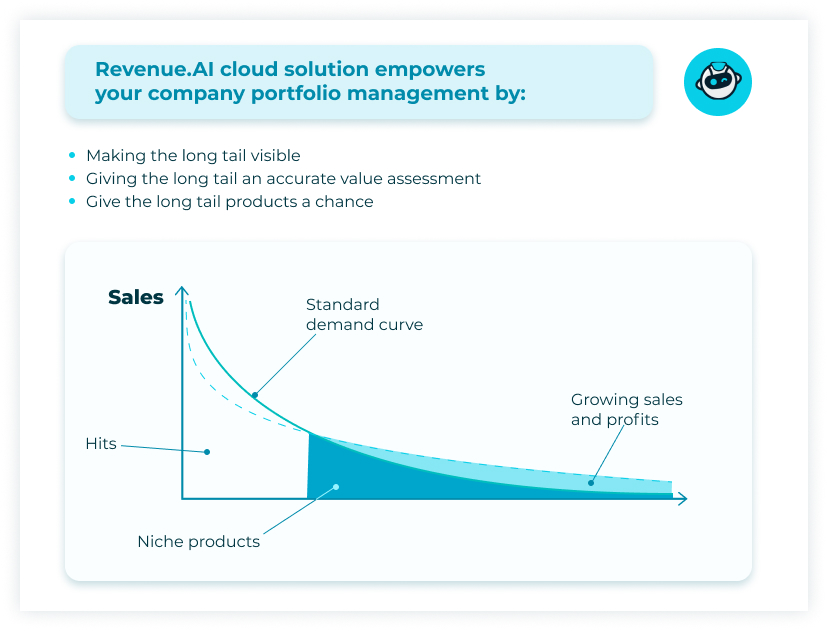Why long tail theory? Well, the landscape of the marketplace has undergone tremendous shifts in the past few years. Spurred on by the digital revolution, the shift away from physical retailers and towards a virtual marketplace, consumers themselves have exercised a shift in their behavior and their needs.
If they don’t want to be left behind, today’s businesses need to understand what these changes mean concretely for the market. They need to adapt to these changes and use their understanding to benefit from the new normal.
In this short article, we’ll take a look at the ripple effects of the shifts in the marketplace. We’ll take a closer look at the long tail and what the implications are for the FMCGs.
In case you are not familiar with the theory, this might be a good pre-read for you.
Do Long Tail Products Matters for Revenue Growth Management in FMCGs?
Long tail products have grown in popularity over the past 10 to 15 years. This is due, in large part, to the boom in eCommerce and the subsequent seismic shift in consumer behavior.
The long tail theory is primarily an online phenomenon whereas FMCGs are dependent on brick-and-mortar distribution outlets. However, the long tail theory accurately explains a shift in consumer behaviour. It would be irresponsible for any manufacturer, regardless of the sector of activity, to ignore a trend in consumer behavior.
Instead, the long tail theory must be understood, and businesses must take the necessary measures to take advantage of this new phenomenon. After all, those who fail to prepare should prepare to fail.
The Long Tail Theory in a Nutshell
In today’s marketplace, which in large part has shifted to the virtual arena, shelf space is not as important of a factor. For example, the limitless shelf space of Amazon.com, in collaboration with AI product recommendations and visibility generated from social media and other such online platforms, means that brands of any size can now compete for a share in the market.
The long tail theory as it pertains to RGM (revenue growth management) states that a viable strategy (especially for small or mid-sized businesses) is to sell a variety of specialized or niche products to a vast array of consumers instead of focusing on only a small range of products targeted to a mass of consumers.
The long tail theory also takes into account the shift in consumer behavior away from traditional major brands towards more unique or specialized products that allow the consumer to express his or her individuality.
How Can FMCGs Fatten the Long Tail and Grow Their Revenue?
We can learn a lot from the e-commerce long tail theory. It describes a shift in consumer behavior and consumer expectations. We can take this understanding and apply it to brick & mortar retailers and product portfolios in FMCGs.
However, when applying principles of the long tail theory to brick & mortar retailers and product portfolios in the FMCGs, we are faced with three problems:
The limited shelf space in brick & mortar retailers
- The long tail theory was born in a virtual environment with unlimited shelf space. Applying the principles of the long tail to an environment with limited shelf space requires tremendous forethought and precision.
The complexity of multiple data sets
- Large companies with SKUs that number in the thousands can’t afford to spend their time on the intricacies of the long tail theory. Even if it would lead to an increase in profits, the time and resources it would take to analyze the necessary data accurately would not prove to be cost-effective.
The lack or inability to implement real-time price changes
- eCommerce channels have the capability to approach dynamic pricing, implement special offers in real time, and manage the demand with immediate pricing changes. But for brick & mortar retailers, we can expect a delay in the execution of these important strategies.
Artificial Intelligence Offers a Solution to These Problems

What was formerly impossible (even unimaginable) for companies to do at scale and in real-time is now possible (even relatively easy) to accomplish with the help of AI.
Revenue.AI cloud solution empowers your company portfolio management by:
Making the long tail visible
Does not matter what kind of data you have. With the Revenue.AI platform’s capability of scraping data from eCommerce sites and then synching them with your master data and other datasets, you will have both a helicopter view and a deep dive into SKU levels for all your competitors’ product ranges.
Giving the long tail an accurate value assessment
With Revenue.AI you will be able to automate the long tail pricing according to your needs. All the while, your team will be able to continue focusing on star products and more traditional pricing strategies.
Give the long tail products a chance
With ML-based mass simulators and intelligent alerts, you will never miss another opportunity for revenue growth. You will find your next star product in the long tail immediately; no need to wait until it’s too late when user behavior changes are reflected in descriptive analytics. Run simulations, manage your pricing strategy easily, and identify and predetermine the best time to act and how.
Take Advantage of The Long Tail Theory And Boost Your Revenue Today
At first glance, it might appear complicated, but you aren’t expected to do it alone. Schedule a demo with an AI expert. Stop losing out on revenue growth. Discover how Revenue AI can empower your growth with AI-augmented teams.






